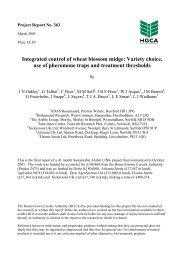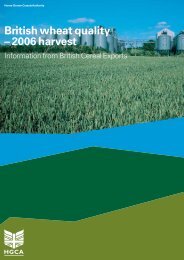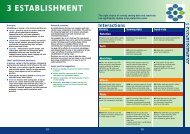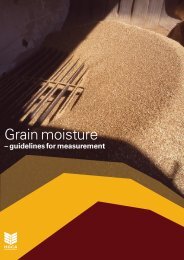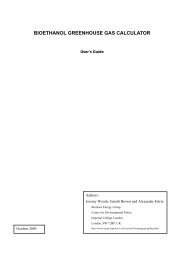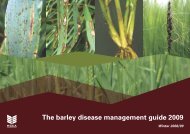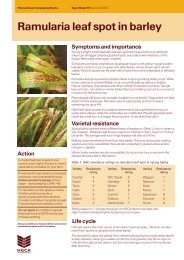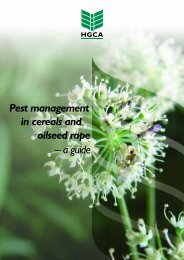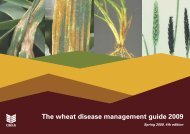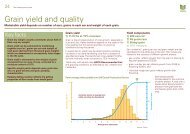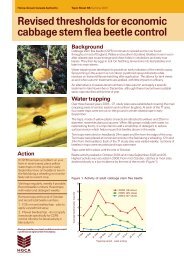the margins may not benefit pest control directly within the field, although they may reduce <strong>pests</strong> utilisingmargins. Araneae especially were shown to have different species composition in margins compared to thecrop (Kromp & Steinberger, 1992) while some carabid species, especially spermophagous species, remainstrongly associated with margins (Cardwell et al., 1994; Holl<strong>and</strong> et al.,1999; Thomas et al., 2001;). Furtherinformation on the species composition <strong>of</strong> sown margins <strong>and</strong> the impact <strong>of</strong> cutting, scarification <strong>and</strong>herbicides will be gained from the SAFFIE project.The establishment <strong>of</strong> grassy margins is one the most widely adopted ES options (Boatman, et al., 2007), but<strong>their</strong> value for <strong>natural</strong> <strong>enemies</strong> has received only limited attention in the UK. In the Arable Stewardship PilotScheme, the abundance <strong>and</strong> species richness <strong>of</strong> carabids was the same grassy margins, beetle banks <strong>and</strong> theopen field, however, the community composition differed reflecting the differences in the environmentalconditions <strong>and</strong> preferences <strong>of</strong> individual taxa (Gardner et al., 1999). Grassy margins were recommended as away <strong>of</strong> enhancing carabid diversity in cereal dominated l<strong>and</strong>scapes (Anon, 2001). The margins were,however, relatively new at the time <strong>of</strong> sampling <strong>and</strong> further changes in <strong>their</strong> invertebrate composition wouldbe expected (Thomas & Marshall, 1999). In the Netherl<strong>and</strong>s, emergence traps placed in grassy marginsrevealed that during the growing season the fauna was comprised mostly <strong>of</strong> dipteran flies, followed byparasitic wasps, spiders, carabid beetles <strong>and</strong> staphylinid beetles (Canters & Tamis, 1999). Numbers <strong>of</strong>Staphylinidae abd Carabidae were higher in the winter showing that they were used as an overwintering site.Mowing lead to increases in parasitic wasps, hoverflies <strong>and</strong> Staphylinidae, but also aphids. Spiders werereduced by mowing.Potential to improve biocontrolMost biocontrol related research on uncultivated habitats has focussed on determining whether <strong>natural</strong><strong>enemies</strong> were enhanced in the adjacent crop rather than the impact on the pest. Furthermore, because therelationship between the level <strong>of</strong> predation <strong>and</strong> abundance <strong>of</strong> <strong>natural</strong> <strong>enemies</strong> remains unquantified, knowingthe abundance <strong>of</strong> <strong>natural</strong> <strong>enemies</strong> does not allow <strong>their</strong> impact to be determined.Natural <strong>enemies</strong> overwintering in field margins were shown to move outwards from field margins in twoways. For those species that walked a wave <strong>of</strong> dispersal was identified, but those that flew achieved rapidcoverage across the whole field (Coombes & Sotherton, 1986; Kromp & Nitzlader, 1995). Even so thedistribution <strong>of</strong> <strong>natural</strong> <strong>enemies</strong> across fields is rarely even, with most showing some degree <strong>of</strong> aggregationinto patches (Holl<strong>and</strong> et al., 1999, 2004b, 2005). Moreover, as the ratio <strong>of</strong> edge to field will decrease as fieldsize increases, so the impact <strong>of</strong> boundary overwintering <strong>natural</strong> <strong>enemies</strong> would be expected to diminish.When the distribution <strong>of</strong> boundary overwintering ground-active predators (Carabidae, Staphylinidae <strong>and</strong>Lycosidae) was examined in the 3D Farming project, they were found throughout the smaller study fieldsduring May <strong>and</strong> June where the distance to the field centre from the boundary was no more than 150 m.However, they did not penetrate the larger fields <strong>and</strong> most patches were located within 100 m <strong>of</strong> the fieldboundary. By July, most were located within 60 m <strong>of</strong> the field boundary (Powell et al., 2004; Holl<strong>and</strong> et al.,49
in prep). Likewise other studies <strong>of</strong> <strong>natural</strong> enemy distributions have found strong evidence <strong>of</strong> aggregationinto patches the size <strong>and</strong> stability <strong>of</strong> the patches, varying between the families <strong>and</strong> species (Ericson, 1978;Hengeveld, 1979; Thomas et al., 1998; Holl<strong>and</strong> et al., 1999; Bohan et al., 2000; Thomas et al., 2006;Fernández-García et al. 2000; Thomas et al., 2001; Holl<strong>and</strong> et al. 2004a, b, 2005). For Carabidae, somespecies remain associated with field margins throughout <strong>their</strong> lives, especially spermophagous species orthose typically found in woodl<strong>and</strong>. In contrast, other taxa that may use grassy field margins foroverwintering (e.g. Linyphiidae) disperse beyond the adjacent fields <strong>and</strong> consequently <strong>their</strong> distribution islargely unaffected by the margins (Holl<strong>and</strong> et al., 1999, 2004). Field overwintering species may use themargins as a foraging resource <strong>and</strong> overwinter within them either as adults or larvae as the soil remainsundisturbed, but the number that do so compared to those within the field is relatively small (Holl<strong>and</strong> et al.,2005).Whether increasing the relative proportion <strong>of</strong> boundary habitat to crop consequently increases <strong>natural</strong> enemydensities within the adjacent fields has not been determined, although there may be other limiting factors thatcontrol densities within fields. Whether wider field margins enhance the levels <strong>of</strong> cereal aphid control is theone <strong>of</strong> the subjects currently being investigated in the RELU funded “Re-bugging the system” project. Initialfindings revealed that the presence <strong>of</strong> 6m wide margins did not improve the levels <strong>of</strong> cereal aphid control,although almost 100% control <strong>of</strong> artificial aphid infestations was achieved in all fields (Holl<strong>and</strong> et al., 2006).Further studies are underway as part this project to determine whether there is a relationship between theproportion <strong>and</strong> type <strong>of</strong> uncropped l<strong>and</strong> in the surrounding l<strong>and</strong>scape, <strong>and</strong> the level <strong>of</strong> cereal aphid control.Further discussion <strong>of</strong> the l<strong>and</strong>scape impact is given below.Not all ground-active <strong>natural</strong> <strong>enemies</strong> overwinter in field boundaries <strong>and</strong> the numerically most dominantspecies <strong>of</strong> Carabidae overwinter as larvae within fields. When the density <strong>of</strong> these two groups was estimated,the contribution <strong>of</strong> the field overwintering species far outweighed that <strong>of</strong> the boundary overwinters, exceptusing the highest estimate <strong>of</strong> <strong>natural</strong> enemy abundance <strong>and</strong> fields surrounded by 6m margins (Holl<strong>and</strong> et al.,2006). However, field overwintering species peak in abundance during July whereas boundary overwinteringspecies peak in May to June. Therefore, even the overall contribution <strong>of</strong> boundary overwintering species maybe smaller, this may occur at a more critical time when <strong>pests</strong> populations are starting to increase, as wasdemonstrated with carabids <strong>and</strong> cereal aphids (Edwards et al., 1979).Exclusion techniques are <strong>of</strong>ten employed to quantify predation <strong>and</strong> isolate the impact <strong>of</strong> different guilds <strong>of</strong><strong>natural</strong> <strong>enemies</strong>. The earliest studies <strong>of</strong> cereal aphid predation revealed that ground-active <strong>natural</strong> <strong>enemies</strong>reduced the number <strong>of</strong> cereal aphids <strong>and</strong> that these were most effective when aphid numbers built up slowly(Edwards et al., 1978, 1979; Sunderl<strong>and</strong> et al., 1980; Chambers et al., 1983; DeClerq & Pietraszko, 1983;Chiverton, 1986; Collins et al., 2002) contributing most during the early stages <strong>of</strong> an aphid infestation(Edwards et al., 1979; Chiverton, 1986). However, sometimes the ground-active <strong>natural</strong> <strong>enemies</strong> wereineffective <strong>and</strong> did not prevent aphids reaching the spray threshold (Burn, 1992; Holl<strong>and</strong> et al., 1997). More50
- Page 1 and 2: Research Review No. 64June 2007Pric
- Page 3 and 4: 4.4 Manipulation of natural enemies
- Page 5 and 6: AbstractPressure to reduce insectic
- Page 7 and 8: 1. IntroductionInsect pest of cerea
- Page 10 and 11: higher in ‘new’ areas.Rape wint
- Page 12 and 13: Potential damage can be caused by t
- Page 14 and 15: loss than the winter generation whi
- Page 16 and 17: 2.12 ‘Wessex’ flea beetle (Psyl
- Page 18 and 19: Cabbage stem flea beetles hatch at
- Page 20 and 21: 4. Review of cereal pest natural en
- Page 23 and 24: midgeContarinia tritici Larva/Pupa
- Page 25 and 26: Cereal ground beetle No infoZabrus
- Page 27 and 28: Myzus persicae Coleoptera Cantharid
- Page 29 and 30: Delia radicum Egg/Larva/Pupa Many C
- Page 31 and 32: Diospilus oleraceus Hymenoptera Bra
- Page 33 and 34: (Biocontrol of Oilseed Rape Insect
- Page 35 and 36: Dolichopodidae (La)Damp areas/Soil/
- Page 37 and 38: 2002). Nevertheless, there have bee
- Page 39 and 40: Therevidae (Stiletto flies) 2 1 2 2
- Page 41 and 42: and further work to examine their d
- Page 43 and 44: ate of repopulation depends on many
- Page 45 and 46: Table 6. Resources provided for nat
- Page 47 and 48: (Crateagus mongyna) supported 209 i
- Page 49: densities varied enormously between
- Page 53 and 54: compared to other cereal crops (Hol
- Page 55 and 56: Wildbird cover can develop a rich u
- Page 57 and 58: females select species with appropr
- Page 59 and 60: Skylark plots were found to support
- Page 61 and 62: Carabid abundance was higher 8m int
- Page 63 and 64: 6. Conclusions on potential of Envi
- Page 65 and 66: Where no noxious weeds or volunteer
- Page 67 and 68: conducted in isolation because of t
- Page 69 and 70: 8. ReferencesAdis, J. (1979) Proble
- Page 71 and 72: Chambers, R. J., Sunderland, K. D.,
- Page 73 and 74: Frampton, G. K., Cilgi, T., Fry, G.
- Page 75 and 76: Holland, J. M., Perry, J. N. & Wind
- Page 77 and 78: Meek, B., Loxton, D., Sparks, T., P
- Page 79 and 80: Sotherton, N. W. (1985) The distrib
- Page 81 and 82: oilseed rape across Europe. The BCP
- Page 83 and 84: 2001 More late August drilled winte
- Page 85 and 86: 1998 August drillings emerged rapid
- Page 87 and 88: Oilseed rapeHarvest Review - pest h
- Page 89 and 90: favoured rapid crop development and
- Page 91 and 92: Harvest year 2005. Substantial reco
- Page 93 and 94: Harvest years 2004 and 2003. Limite
- Page 95 and 96: Harvest year 2005. Low numbers of o
- Page 97 and 98: Harvest year 2006. Moderate to high
- Page 99 and 100: Harvest year 2007 (to date). Increa
- Page 101 and 102:
Appendix 4. Current and recent comp
- Page 103 and 104:
LINK funded projects - current25 Ma
- Page 105 and 106:
Appendix 5. List of British researc




